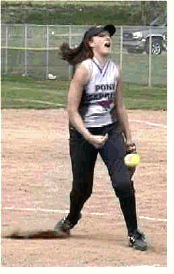|
by Gerald Warner, Softball Pitching
Instructor

We did an extensive 3-year study on the
basic subject of pitch placement and
which locations resulted in
the most hits, and which resulted in 3rd
strikes.

This
is a subject where each of us feels we are THE expert…coaches,
parents, and pitchers…all of us have our opinions of where to throw
certain pitches – low and inside, up and away, on the batter’s
hands, a “chase” pitch low and outside, etc. Typically, the pitch
and location are called by the catcher or dugout coach based on the
batter and the situation.
But after studying thousands of during-the-game pitches (*)
thrown by travel ball, college, and high school pitchers, we
now have some statistics to support what many coaches and
pitchers have always emphasized.
Read
the notes at the bottom of this page to see how and where we
observed pitch locations.
We looked at pitches on whether they were above or below the
top of the thigh…essentially at the point where the leg meets the
body. It certainly was
not scientifically nor statistically perfect, and was often based on
an opinion of where the ball crossed the plate, but it does give an
accurate representation of what happened. Here is a summary of
the results:
78%
of all hits were from pitches above the batter’s
thigh
22%
of all hits were from pitches below the top of the
thigh
39%
of
3rd strikes were from high pitches
(chest
to top of the thigh)
61%
of 3rd strikes were from low pitches
(knees
to top of the thigh)
Many
of the upper-half hits were either from rise balls that didn’t rise
(flattened out), or from fastballs that went above their mark. However, with
some of the younger travel ball teams and high school games, we
actually observed coach/dugout calls for waist-to-chest-high
fastballs…that, needless to say, resulted in some BIG hits. The majority of the
lower-half strikeouts were from down-and-in fastballs, good drop
balls, and outside curves.
“KEEP IT
LOW”
We
recommend never throwing high fastballs especially over the
outside half of the plate (zones 4, 5, 7, and 8). Instead, use the inside
corners, and the low-outside corner. Our advice for most
situations is to keep the fastball low, and use only the screw ball
or rise ball for upper-half pitches. We also like to see pitchers
occasionally use a down-and-in rise or screw. A screw ball thrown to
an opposite-handed batter can also be thrown low-and-away …making it
a good “chase” pitch.
For most drop ball, change-up, and curve ball situations, the
best location is low and away.
* Pitch
placement was determined by recording at what level the ball crossed
the plate or was hit…in the strike zone below the top of the
batter’s thigh, or above the top of the thigh. Our observation point
was always at a sideline location down the 1st or
3rd baseline, and therefore either facing or behind the
batter.
All data was collected from 14U-A to 18U-Gold travel ball
games, Division I college games, and a handful of high school
games.
Among the tournaments where pitch placement was recorded were
the Colorado Fireworks Tournaments (over 200 14U-18U travel
ball teams participate each year), the Boulder Independence Day
Tournament, the NCAA College World Series in Oklahoma
City, and the former Kia Classic and Judi Garman
Classic in Fullerton, California.
The article
above can be downloaded and printed from Microsoft
Word

Do you want to reprint
this article or use it on your website or in your
newsletter?
As long as it is not for profit,
our only requirement is that you first notify us, then include the
following sentence:
Article by Gerald Warner of
PitchSoftball.com
and include a reference to this
website: www.pitchsoftball.com
If
you have questions or need more information
E-mail us, or call Pitching Instructor Gerald Warner in
Colorado at (720) 200-4575
| 











